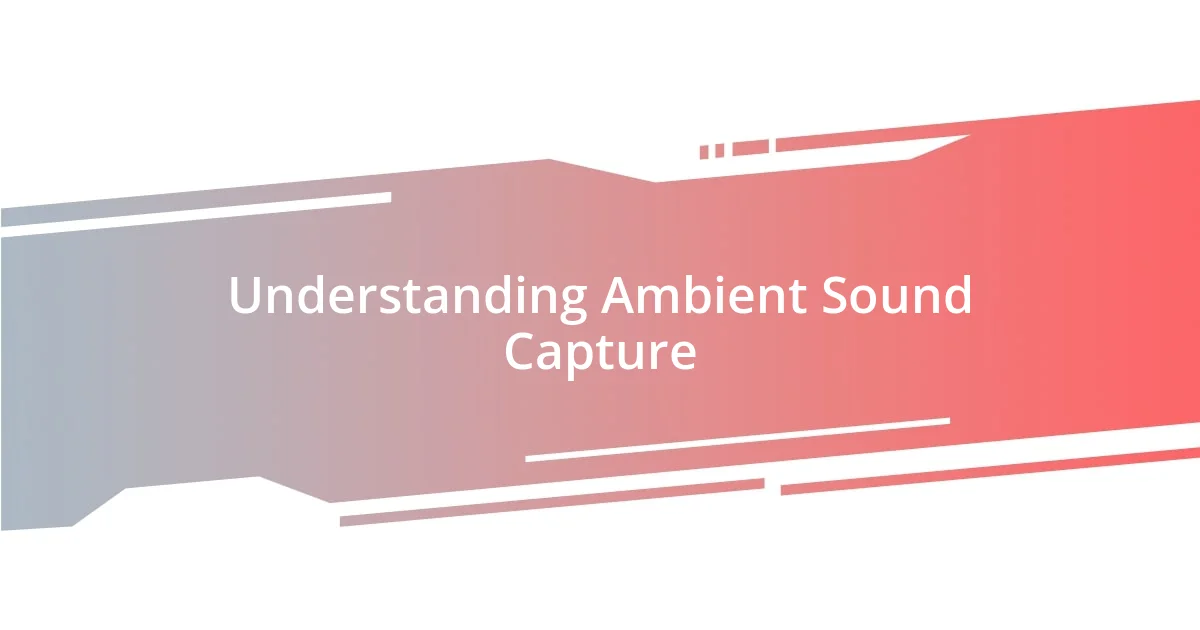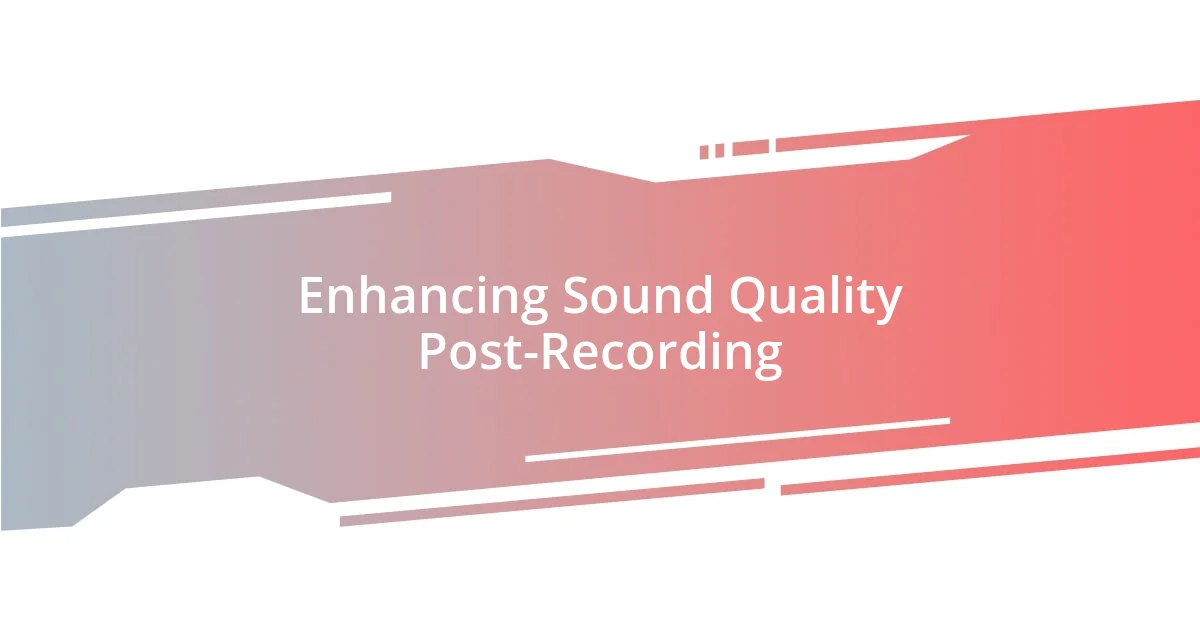Key takeaways:
- Understanding ambient sound capture involves careful consideration of environment, equipment, and techniques to ensure high-quality recordings.
- Post-recording editing is crucial for enhancing sound quality, including using noise reduction, layering sounds, and experimenting with effects like reverb.
- Ambient sounds have diverse applications in relaxation, film, and education, demonstrating their power to influence emotions and enhance experiences.

Understanding Ambient Sound Capture
Understanding ambient sound capture is an intricate process that goes beyond just recording noises. I remember the first time I ventured outside with my microphone, feeling both excitement and nervousness. Would the distant rustle of leaves and the soft chirping of birds translate well into my recording? That moment taught me that every subtle sound layer contributes to creating a rich audio tapestry.
When I think about the various environments for recording ambient sounds, I often ponder how different settings offer unique sonic experiences. For instance, the tranquility of a forest in early morning contrasts sharply with the bustling sounds of a city street. Isn’t it fascinating how each place has its own “voice”? It’s like every setting tells a story, provided you’re listening attentively.
Crucially, the equipment you use can greatly impact your sound capture. I learned this the hard way when my first recordings came out muffled because I didn’t consider the mic placement. This experience underscored the importance of knowing your tools and their capabilities—it’s about capturing not just sound, but the emotion and atmosphere behind it. How do you ensure you’re getting the essence of a moment? In my experience, it often comes down to patience and a little experimentation.

Choosing the Right Equipment
When it comes to choosing the right equipment for ambient sound capture, I always emphasize the importance of quality over quantity. During one of my early recordings, I found myself muscling through a session with a subpar microphone. The result? A cacophony of disappointing sounds that left me feeling frustrated. Investing in a decent microphone made a world of difference. You don’t need the fanciest gear, but a reliable setup can elevate your recordings tremendously.
Here are some key points to consider when selecting your equipment:
- Microphone Type: Consider a shotgun mic for focused sound or an omnidirectional mic for capturing more ambient noise.
- Field Recorder Quality: Look for a portable recorder with good preamps for crystal clear audio.
- Wind Protection: Don’t forget a windscreen; even a gentle breeze can cloud your recordings.
- Headphones: Good closed-back headphones help you monitor sound accurately during recordings.
- Accessories: Tripods or stabilizers prevent unwanted movement and noises.
Ultimately, finding the right equipment can save you time and ensure that every enchanting moment is captured with precision.

Techniques for Sound Isolation
Sound isolation is key to capturing the essence of ambient sounds without unwanted interference. I distinctly remember one recording session where the sounds of the bustling crowd were overpowering the delicate chirps of nearby birds. It dawned on me that choosing the right location was vital for isolating these sounds. Finding a quiet nook away from the chaos helped me focus on the softer nuances of nature, elevating the quality of my recording.
In my experience, using tools and techniques that enhance sound isolation makes all the difference. Techniques like strategically placing sound barriers, using acoustic blankets, or even simply recording during quieter times can drastically reduce background noise. I recall a session at a park where I set up my recording equipment near a fountain, but the water splashes created unwanted artifacts in my audio. Moving a few feet away allowed me to hone in on the soothing rustle of trees instead, highlighting how a slight adjustment can lead to a major improvement.
Another approach is to utilize directional microphones which naturally reject sounds from behind. I often rely on shotgun mics when I’m outdoors; they help in isolating the sound source I want while minimizing background noise. The thrill of capturing a clear ambient layer impresses upon my memory, further reinforcing the need for sound isolation in achieving those perfect recordings.
| Technique | Description |
|---|---|
| Choosing a Recording Location | Find quiet spaces away from noise sources to enhance sound quality. |
| Using Acoustic Barriers | Implement sound-proofing techniques with blankets or portable barriers to muffle surrounding noise. |
| Directional Microphones | Opt for shotgun mics to focus on a specific sound source, minimizing background interference. |
| Recording Timing | Select times when ambient noise is minimal to ensure clarity in sound capture. |

Best Practices for Recording
When I set up for a recording, I always check my surroundings first. I vividly remember one serene morning by a lakeside, where the gentle lapping of water was my desired sound. Yet, I was met with the distant rumble of traffic. I couldn’t help but think, how can something so peaceful be disturbed by urban life? It taught me the importance of not just choosing the right time but also the right place for my recordings.
Another best practice I’ve found crucial is to double-check connections and settings before hitting record. During a particularly exciting session, I was ready to capture an unexpected thunderstorm when I realized my microphone wasn’t plugged in properly. The disappointment was palpable, and I learned the hard way that a moment of distraction can lead to lost opportunities. Now, I always run a quick sound check to ensure everything is in order; it’s a simple habit that pays off immensely.
Finally, consider the impact of movement during your recordings. I’ve had instances where a slight shift in my position altered the audio landscape I’d been striving for. If I remain still, the clarity of the sound improves. Reflecting on this, I often ask myself: how often do we overlook the smaller details that can dramatically enhance our results? I suggest using a tripod or stabilizer to keep your equipment steady, allowing you to concentrate fully on the exquisite sounds around you.

Editing Ambient Sounds Effectively
Editing ambient sounds is a crucial phase that can transform a good recording into a truly mesmerizing one. I recall a time when I was sifting through audio files from a rainy day in the forest. The raw sounds of raindrops on leaves were beautiful, but some unwanted noise from distant traffic crept in. This experience taught me the importance of using noise reduction tools in my editing software. By applying a gentle filter and tweaking the EQ, it was like a fog lifting, revealing the serene ambiance I had hoped to capture.
As I edit, I often find that layering different sounds can create a more immersive atmosphere. There’s a particular session where I combined the recording of wind rustling through grass with faint birdsong in the background. The blend added depth; I was suddenly transported back to that tranquil moment. It made me realize that sometimes the magic lies not just in capturing sound but how we arrange and juxtapose these layers during editing. Have you ever played with layers in your own audio projects? It can be a delightful exploration that enhances the listening experience.
Lastly, I emphasize the value of listening critically while editing. I’ve had moments when I thought a recording was complete, only to notice subtle imbalances in the sound levels. It’s easy to overlook details, especially when you’re excited about your work. I suggest taking breaks and then returning to your edits with fresh ears. You might be surprised at what you catch. This practice has not only improved my edits but has also forged a deeper connection with the sounds I love. Don’t underestimate the power of a well-tuned ear!

Enhancing Sound Quality Post-Recording
When it comes to enhancing sound quality post-recording, one technique I swear by is the use of spectral editing. I remember an editing session where I discovered a persistent hum from electrical equipment in the background of what should have been a peaceful nature soundscape. I felt a sense of frustration wash over me at first, but then I learned how to isolate and remove the offending frequency. The transformation was astounding—suddenly, the calming sounds of nature emerged, and I could almost feel the breeze again. Have you ever had a similar “aha” moment while editing?
One aspect that’s often overlooked is the application of reverb. I recently experimented with adding a slight reverb effect to a recording of ocean waves. At first, I was hesitant, fearing it might cloud the clarity. But when I adjusted the settings just right, the sound enveloped me like a warm blanket, making the listener feel as if they were right there on the beach. It made me wonder: how often do we shy away from experimentation for fear of messing things up? Sometimes, that little risk can lead to the most enchanting results.
I also believe in the power of referencing other tracks during the editing process. I often pull up a few of my favorite ambient recordings to compare sound quality and balancing. While working on a mix of evening crickets and rustling leaves, I realized my own recording was lacking a certain richness. By putting on a professional track, I immediately identified where I could improve—more subtle layering was needed. I encourage you to listen alongside your favorites; it’s a remarkable way to ignite ideas and elevate your sound editing to the next level. What if that small change you make could result in an unforgettable auditory experience? It’s definitely worth exploring!

Applications of Ambient Sound
One of the most fascinating applications of ambient sound is in the realm of relaxation and meditation. I remember the first time I used a gentle forest ambiance during a yoga class. The soothing blend of birds chirping and leaves rustling helped create a tranquil atmosphere, allowing participants to sink deeper into their practice. It struck me how powerful sound can be in influencing our state of mind. Have you ever noticed how certain sounds can transport you to a peaceful place? It’s remarkable how a simple recording can elicit such a profound emotional response.
Beyond relaxation, I find that ambient sound is vital in film and multimedia projects. One particular short film I worked on featured a scene set in a bustling café, but without the perfect background chatter and clinking of cups, it felt lifeless. By carefully layering ambient sounds, I crafted an auditory backdrop that not only added realism but also enriched the emotional experience for viewers. This made me think about the role sound plays in storytelling. Have you considered how background sound can enhance narrative depth in your own projects? It’s a game changer!
Lastly, ambient sound finds its way into the realm of education and virtual learning. I vividly recall a workshop where we experimented with different soundscapes to enhance concentration during study sessions. One participant shared that playing a recording of a gentle rain helped them focus better on their reading. This experience reinforced my belief in the importance of sound in our daily lives. How might you incorporate ambient sound into your own learning environment? With just a little effort, you could create an atmosphere that fosters productivity and inspiration!















